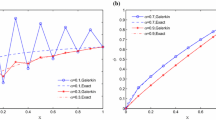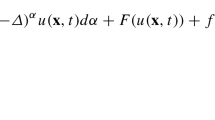Abstract
Meshfree methods with arbitrary order smooth approximation are very attractive for accurate numerical modeling of fractional differential equations, especially for multi-dimensional problems. However, the non-local property of fractional derivatives poses considerable difficulty and complexity for the numerical simulations of fractional differential equations and this issue becomes much more severe for meshfree methods due to the rational nature of their shape functions. In order to resolve this issue, a new weak formulation regarding multi-dimensional Riemann–Liouville fractional diffusion equations is introduced through unequally splitting the original fractional derivative of the governing equation into a fractional derivative for the weight function and an integer derivative for the trial function. Accordingly, a Petrov–Galerkin finite element-meshfree method is developed, where smooth reproducing kernel meshfree shape functions are adopted for the trial function approximation to enhance the solution accuracy, and the discretization of weight function is realized by the explicit finite element shape functions with an analytical fractional derivative evaluation to further reduce the computational complexity and improve efficiency. The proposed method enables a direct and efficient employment of meshfree approximation, and also eliminates the undesirable singular integration problem arising in the fractional derivative computation of meshfree shape functions. A nonlinear extension of the proposed method to the fractional Allen–Cahn equation is presented as well. The effectiveness of the proposed methodology is consistently demonstrated by numerical results.



































Similar content being viewed by others
References
Miller KS, Ross B (1993) An introduction to the fractional calculus and differential equations. Wiley, Hoboken
Podlubny I (1999) Fractional differential equations. Academic Press, Cambridge
Kilbas AA, Srivastava HM, Trujillo JJ (2006) Theory and applications of fractional differential equations. Elsevier, Amsterdam
Yang X, Machado JT (2017) A new fractional operator of variable order: application in the description of anomalous diffusion. Physica A 481:276–283
Zhang X, Liu L, Wu Y, Wiwatanapataphee B (2017) Nontrivial solutions for a fractional advection dispersion equation in anomalous diffusion. Appl Math Lett 66:1–8
Weron A, Janczura J, Boryczka E, Sungkaworn T, Calebiro D (2019) Statistical testing approach for fractional anomalous diffusion classification. Phys Rev E 99:042149
Chang A, Sun H (2018) Time-space fractional derivative models for CO2 transport in heterogeneous media. Fract Calc Appl Anal 21:151–173
Obembe AD, Hossain ME, Abu-Khamsin SA (2017) Variable-order derivative time fractional diffusion model for heterogeneous porous media. J Petrol Sci Eng 152:391–405
Ezzat MA (2010) Thermoelectric MHD non-Newtonian fluid with fractional derivative heat transfer. Physica B 405:4188–4194
Feng L, Liu F, Turner I, Zheng L (2018) Novel numerical analysis of multi-term time fractional viscoelastic non-Newtonian fluid models for simulating unsteady MHD Couette flow of a generalized Oldroyd-B fluid. Fract Calc Appl Anal 21:1073–1103
Meerschaert MM, Tadjeran C (2004) Finite difference approximations for fractional advection–dispersion flow equations. J Comput Appl Math 172:65–77
Lin Y, Xu CJ (2007) Finite difference/spectral approximations for the time-fractional diffusion equation. J Comput Phys 225:1533–1552
Alikhanov AA (2015) A new difference scheme for the time fractional diffusion equation. J Comput Phys 280:424–438
Guo X, Li Y, Wang H (2018) A fourth-order scheme for space fractional diffusion equations. J Comput Phys 373:410–424
Duo S, Wyk HW, Zhang Y (2018) A novel and accurate finite difference method for the fractional Laplacian and the fractional Poisson problem. J Comput Phys 355:233–252
Tang S, Ying Y, Lian Y, Lin S, Yang Y, Wagner GJ, Liu WK (2016) Differential operator multiplication method for fractional differential equations. Comput Mech 58:879–888
Jia J, Wang H (2016) A fast finite volume method for conservative space-fractional diffusion equations in convex domains. J Comput Phys 310:63–84
Simmons A, Yang Q, Moroney T (2017) A finite volume method for two-sided fractional diffusion equations on non-uniform meshes. J Comput Phys 335:747–759
Li J, Liu F, Feng L, Turner I (2017) A novel finite volume method for the Riesz space distributed-order advection–diffusion equation. Appl Math Model 46:536–553
Deng W (2008) Finite element method for the space and time fractional Fokker–Planck equation. SIAM J Numer Anal 47:204–226
Zhao Y, Zhang Y, Shi D, Liu F, Turner I (2016) Superconvergence analysis of nonconforming finite element method for two-dimensional time fractional diffusion equations. Appl Math Lett 59:38–47
Lian Y, Ying Y, Tang S, Lin S, Wagner GJ, Liu WK (2016) A Petrov–Galerkin finite element method for the fractional advection–diffusion equation. Comput Methods Appl Mech Eng 309:388–410
Luan S, Lian Y, Ying Y, Tang S, Wagner GJ, Liu WK (2017) An enriched finite element method to fractional advection–diffusion equation. Comput Mech 60:181–201
Lin Z, Wang D (2018) A finite element formulation preserving symmetric and banded diffusion stiffness matrix characteristics for fractional differential equations. Comput Mech 62:185–211
Xu Q, Hesthaven JS (2014) Stable multi-domain spectral penalty methods for fractional partial differential equations. J Comput Phys 257:241–258
Zayernouri M, Ainsworth M, Karniadakis GE (2015) A unified Petrov–Galerkin spectral method for fractional PDEs. Comput Methods Appl Mech Eng 283:1545–1569
Song F, Xu CJ, Karniadakis GE (2016) A fractional phase-field model for two-phase flows with tunable sharpness: algorithms and simulations. Comput Methods Appl Mech Eng 305:376–404
Mao Z, Shen J (2017) Hermite spectral methods for fractional PDEs in unbounded domains. SIAM J Sci Comput 39:A1928–A1950
Wang J, Xiao A (2019) Conservative Fourier spectral method and numerical investigation of space fractional Klein–Gordon–Schrödinger equations. Appl Math Comput 350:348–365
Belytschko T, Krongauz Y, Organ D, Fleming M, Krysl P (1996) Meshless methods: an overview and recent developments. Comput Methods Appl Mech Eng 139:3–47
Liu WK, Chen Y, Jun S, Chen JS, Belytschko T, Pan C, Uras RA, Chang CT (1996) Overview and applications of the reproducing kernel particle methods. Arch Comput Methods Eng 3:3–80
Atluri SN, Shen S (2002) The meshless local Petrov–Galerkin (MLPG) method. Tech Science, Henderson
Babuška I, Banerjee U, Osborn JE (2003) Survey of meshless and generalized finite element methods: a unified approach. Acta Numer 12:1–125
Li S, Liu WK (2004) Meshfree particle methods. Springer, Berlin
Zhang X, Liu Y (2004) Meshless methods. Tsinghua University Press & Springer, Beijing
Nguyen VP, Rabczuk T, Bordas S, Duflot M (2008) Meshless methods: a review and computer implementation aspects. Math Comput Simul 79:763–813
Liu GR (2009) Meshfree methods: moving beyond the finite element method, 2nd edn. CRC Press, Boca Raton
Chen JS, Hillman M, Chi SW (2017) Meshfree methods: progress made after 20 years. J Eng Mech ASCE 143:04017001
Wang D, Wu J (2019) An inherently consistent reproducing kernel gradient smoothing framework toward efficient Galerkin meshfree formulation with explicit quadrature. Comput Methods Appl Mech Eng 349:628–672
Zhuang P, Gu YT, Liu F, Turner I, Yarlagadda PK (2011) Time-dependent fractional advection–diffusion equations by an implicit MLS meshless method. Int J Numer Methods Eng 88:1346–1362
Liu Q, Gu YT, Zhuang P, Liu F, Nie Y (2011) An implicit RBF meshless approach for time fractional diffusion equations. Comput Mech 48:1–12
Mohebbi A, Abbaszadeh M, Dehghan M (2013) The use of a meshless technique based on collocation and radial basis functions for solving the time fractional nonlinear Schrödinger equation arising in quantum mechanics. Eng Anal Bound Elem 37:475–485
Lian Y, Gregory JW, Liu WK (2017) A meshfree method for the fractional advection–diffusion equation. In: Griebel M, Schweitzer M (eds) Meshfree methods for partial differential equations VIII. Springer, Cham, pp 53–66
Ying Y, Lian Y, Tang S, Liu WK (2018) Enriched reproducing kernel particle method for fractional advection–diffusion equation. Acta Mech Sin 34:515–527
Lin Z, Liu F, Wang D, Gu YT (2018) Reproducing kernel particle method for two-dimensional time-space fractional diffusion equations in irregular domains. Eng Anal Bound Elem 97:131–143
Tayebi A, Shekari Y, Heydari MH (2017) A meshless method for solving two-dimensional variable-order time fractional advection–diffusion equation. J Comput Phys 340:655–669
Shekari Y, Tayebi A, Heydari MH (2019) A meshfree approach for solving 2D variable-order fractional nonlinear diffusion-wave equation. Comput Methods Appl Mech Eng 350:154–168
Hussain M, Haq S, Ghafoor A (2020) Meshless RBFs method for numerical solutions of two-dimensional high order fractional Sobolev equations. Comput Math Appl 79:802–816
Nayroles B, Touzot G, Villon P (1992) Generalizing the finite element method: diffuse approximation and diffuse elements. Comput Mech 10:307–318
Belytschko T, Lu YY, Gu L (1994) Element-free Galerkin methods. Int J Numer Methods Eng 37:229–256
Liu WK, Jun S, Zhang YF (1995) Reproducing kernel particle methods. Int J Numer Methods Fluids 20:1081–1106
Chen JS, Pan C, Wu CT, Liu WK (1996) Reproducing kernel particle methods for large deformation analysis of non-linear structures. Comput Methods Appl Mech Eng 139:195–227
Wu CT, Park CK, Chen JS (2011) A generalized approximation for the meshfree analysis of solids. Int J Numer Methods Eng 85:693–722
Wang D, Chen P (2014) Quasi-convex reproducing kernel meshfree method. Comput Mech 54:689–709
Yin B, Liu Y, Li H, He S (2019) Fast algorithm based on TT-M FE system for space fractional Allen–Cahn equations with smooth and non-smooth solutions. J Comput Phys 379:351–372
Zheng L, Zhang X (2017) Modeling and analysis of modern fluid problems. Academic Press, Cambridge
Roop JP (2006) Computational aspects of FEM approximation of fractional advection dispersion equations on bounded domains in R2. J Comput Appl Math 193:243–268
Teodoro GS, Machado JT, Oliveira EC (2019) A review of definitions of fractional derivatives and other operators. J Comput Phys 388:195–208
Samko SG, Kilbas AA, Marichev OI (1993) Fractional integrals and derivatives: theory and applications. Gordon and Breach Science Publishers, London
Lions JL, Magenes E (1972) Non-homogeneous boundary value problems and applications. Springer, Berlin
Li X, Xu CJ (2009) A space-time spectral method for the time fractional diffusion equation. SIAM J Numer Anal 47:2108–2131
Zhao Y, Bu WP, Zhao X, Tang YF (2017) Galerkin finite element method for two-dimensional space and time fractional Bloch–Torrey equation. J Comput Phys 350:117–135
Feng L, Liu F, Turner I (2019) Finite difference/finite element method for a novel 2D multi-term time-fractional mixed sub-diffusion and diffusion-wave equation on convex domains. Commun Nonlinear Sci Numer Simul 70:354–371
Shen J, Tang T, Wang L (2011) Spectral methods: algorithms, analysis and applications. Springer, Berlin
Li X, Xu CJ (2010) Existence and uniqueness of the weak solution of the space-time fractional diffusion equation and a spectral method approximation. Commun Comput Phys 8:1016–1051
Acknowledgements
The support of this work by the National Natural Science Foundation of China (11772280, 11472233) and the SIAT Innovation Program for Excellent Young Researchers is gratefully acknowledged.
Author information
Authors and Affiliations
Corresponding author
Additional information
Publisher's Note
Springer Nature remains neutral with regard to jurisdictional claims in published maps and institutional affiliations.
Rights and permissions
About this article
Cite this article
Lin, Z., Wang, D., Qi, D. et al. A Petrov–Galerkin finite element-meshfree formulation for multi-dimensional fractional diffusion equations. Comput Mech 66, 323–350 (2020). https://doi.org/10.1007/s00466-020-01853-x
Received:
Accepted:
Published:
Issue Date:
DOI: https://doi.org/10.1007/s00466-020-01853-x




